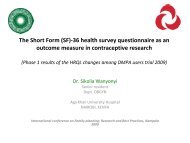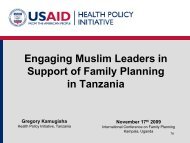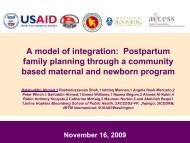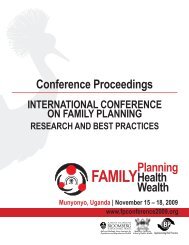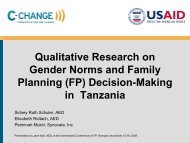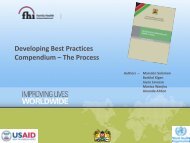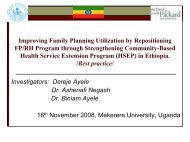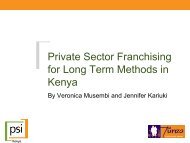structural roots of gbv and how it expresses itself through sexual
structural roots of gbv and how it expresses itself through sexual
structural roots of gbv and how it expresses itself through sexual
You also want an ePaper? Increase the reach of your titles
YUMPU automatically turns print PDFs into web optimized ePapers that Google loves.
stereotypes <strong>and</strong> power male to female relations prevail in the family, school, training<br />
<strong>and</strong> work environment, commun<strong>it</strong>y, health providers, <strong>and</strong> legal <strong>and</strong> judiciary system.<br />
This has led to Peru having among the worse Gender Development Indexes <strong>of</strong> the world<br />
(World Economic Forum, 2005) <strong>and</strong> being one <strong>of</strong> the two countries having all <strong>of</strong> the<br />
gender indicators under the world mean.<br />
Not only the country is patriarchal <strong>and</strong> sexist, but “Machismo” (“Macho” culture) is<br />
generalized. A 2008 survey carried by the Universidad de Lima s<strong>how</strong>ed 85% <strong>of</strong> Lima<br />
population believed Peruvian society to be sexist <strong>and</strong> that “Machism” prevailed.<br />
Women are considered <strong>of</strong> less value, males using force, violence, <strong>and</strong> other forms <strong>of</strong><br />
power to control female <strong>sexual</strong><strong>it</strong>y, reproduction, economy <strong>and</strong> lives, <strong>and</strong> evading <strong>sexual</strong><br />
<strong>and</strong> reproductive responsibil<strong>it</strong>ies, as a series <strong>of</strong> studies <strong>and</strong> publications attest. Peru has<br />
the worse economic gender gap in Latin America (UNIFEM 2003). In this context, a<br />
2009 Ombudsman <strong>of</strong>ficial report s<strong>how</strong>s a national mean <strong>of</strong> 42% <strong>of</strong> Peruvian urban<br />
women reporting being victims <strong>of</strong> physical violence by their intimate partner, ascending<br />
to 46% in the Amazon.<br />
In poor rural commun<strong>it</strong>ies men refer women “have to be kicked as a sack <strong>of</strong> potatoes so<br />
that they do not try to equalize w<strong>it</strong>h the husb<strong>and</strong>”, as found in a Population Council<br />
study we conducted some years ago.<br />
Peru is a highly diverse country in terms <strong>of</strong> race, ethnic groups, cultures, religions,<br />
geographic regions –Coastal Desert, Amazonian Jungle, <strong>and</strong> Andean Highl<strong>and</strong>s-,<br />
socioeconomic <strong>and</strong> urban development.<br />
Amazon IndigenousWoman<br />
Cred<strong>it</strong>s: Javier Silva<br />
Peru has among the highest w<strong>it</strong>hin-country socioeconomic gaps in the world, <strong>and</strong> half<br />
the population is poor, leading to adolescent girls living in extremely different real<strong>it</strong>ies<br />
w<strong>it</strong>h regard to their <strong>sexual</strong> <strong>and</strong> reproductive health, depending if they live in urban,<br />
semi-urban or rural settings <strong>and</strong> in the degree <strong>of</strong> poverty <strong>and</strong> marginalization.




